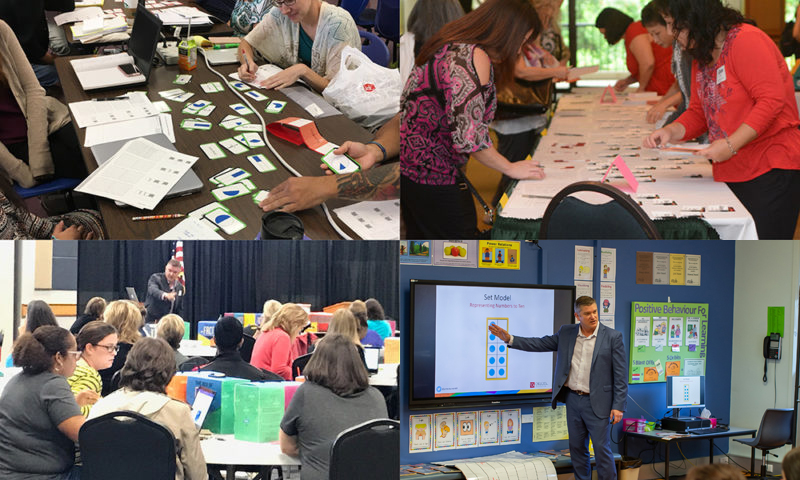Insights
Building a Math PLC: Collaboration for Stronger Instruction
Math instruction is constantly evolving, and as educators, we grow best when we learn from one another. That’s where a Professional Learning Community (PLC) comes in! A math PLC is a group of educators working together to improve math instruction, share best practices, and support student success. Whether you’re just starting or looking to strengthen an existing PLC, building a collaborative math team can transform teaching and learning.
Why Create a Math PLC?
A well-structured PLC benefits both teachers and students. Studies have shown that:
- PLCs increase student achievement – A meta-analysis by Vescio, Ross, & Adams (2007) found that PLCs have a positive impact on student learning by creating more cohesive and research-driven teaching strategies.
- Teachers in PLCs feel more engaged and supported – According to a report by the Learning Policy Institute (2017), when teachers participate in ongoing, collaborative professional learning, they are more likely to stay in the profession and feel job satisfaction.
- PLCs improve instructional consistency – A study by Linder, Post, & Calabrese (2012) found that when teachers collaborate in a PLC, they align instruction, leading to more effective and consistent math teaching across classrooms.

Steps to Building a Math PLC
Creating a PLC centered on math instruction can strengthen teaching practices and improve student learning. A well-structured PLC allows educators to collaborate, reflect, and refine their approaches to teaching math in meaningful ways. Follow these five key steps to establish a productive and engaging math PLC:
1. Use Student Work and Data to Guide Discussions
Effective PLCs go beyond theory—they focus on student learning. Bring student work samples, assessment data, or classroom observations to analyze together. Ask:
- What do students understand?
- Where are they struggling?
- How can we adjust instruction to better support them?
2. Start with a Shared Vision
A successful PLC begins with a common goal: What do you want to achieve?
Your PLC might focus on improving math discourse, implementing hands-on learning, or boosting problem-solving skills. Having a clear purpose keeps your meetings productive and impactful.
If you find your team wants to achieve all of the above, start with the the goal that is most needed for your students at the moment (based on student data).

3. Set a Regular Meeting Schedule
Consistency is key! Decide how often to meet—weekly, biweekly, or monthly—and stick to it. Keep meetings focused and efficient by setting an agenda in advance.
4. Collaborate on Lesson Planning
Planning together reduces workload and ensures alignment across classrooms. Try:
- Lesson studies – Teach a lesson, observe each other, and refine it.
- Task analysis – Break down a math problem to uncover misconceptions.
- Resource sharing – Swap engaging activities, math games, or anchor charts.

5. Encourage Open Dialogue and Reflection
A strong PLC thrives on trust and collaboration. Keep discussions solution-focused and encourage teachers to share both successes and challenges. Questions to spark discussion include:
- What strategies are working in your classroom?
- How do you engage students in productive struggle?
- What’s one math misconception your students have, and how are you addressing it?
Overcoming Challenges in a Math PLC
Even with the best intentions, PLCs can face roadblocks. Understanding these challenges—and how to navigate them—can make your math PLC more effective and sustainable.
Limited Time
Between lesson planning, grading, and supporting students, teachers already have full plates. Finding dedicated time for a PLC can feel impossible, especially when meetings get overshadowed by other school commitments. However, even small moments of collaboration can have a big impact. Make the most of short, structured meetings by keeping agendas focused and meetings efficient by setting clear objectives. You can also:
- Use digital collaboration tools. Google Docs, Padlet, or shared spreadsheets allow teachers to discuss strategies and share resources between meetings.
- Embed PLC time into the school day. Advocate for dedicated collaboration time, such as during a planning period or faculty meeting.

Differing Teaching Philosophies
Every teacher brings their own background, experiences, and beliefs about math instruction. While diverse perspectives can enrich discussions, they can also create tension if educators strongly disagree on teaching methods.
To avoid this, keep discussions centered on what works best for students, rather than personal preferences. Encourage teachers to try different approaches in their classrooms and reflect on the results together before dismissing them.
For those moments where the philosophies collide, go back to the research. Refer to studies on effective math instruction to help align teaching strategies with best practices.
Lack of Administrator Support
For a PLC to thrive, school leadership must value and support collaborative professional learning. Without administrator buy-in, PLCs can feel like an extra burden rather than a meaningful tool for growth. Here are a few ways to help encourage support from administration:
- Show how PLCs improve student outcomes. Use research-backed evidence (like the studies mentioned above) to demonstrate how collaboration enhances instruction.
- Request dedicated PLC time. If your school doesn’t prioritize collaboration, propose a plan for structured PLC meetings during in-service days or team planning periods.
- Communicate successes. Share how your PLC is positively impacting student learning—administrators are more likely to support something when they see results.

ORIGO Education Can Support Your Math PLC
Building a strong math PLC requires the right resources and support, and ORIGO Education provides tools to help educators collaborate effectively. ORIGO offers comprehensive math programs, professional learning resources, and engaging instructional materials that align with best practices in math education. This includes:
- Professional Learning Resources – ORIGO provides research-based professional development that supports teachers in deepening their math instruction and working collaboratively within a PLC.
- Lesson and Strategy Support – With ORIGO’s resources, educators can analyze math concepts together, ensuring consistency in instruction and addressing student misconceptions as a team. Check out ORIGO’s webinar series here!
- Ready-to-Use Classroom Materials – From engaging problem-solving tasks to conceptual math lessons, ORIGO’s resources provide PLCs with practical tools to enhance instruction and student understanding.
By integrating ORIGO Education into your PLC, you can create a more cohesive, research-driven, and effective approach to math instruction that benefits both teachers and students. Remember, a math PLC is more than just a meeting—it’s a culture of collaboration that empowers educators and enhances student learning. When teachers work together, students win!



